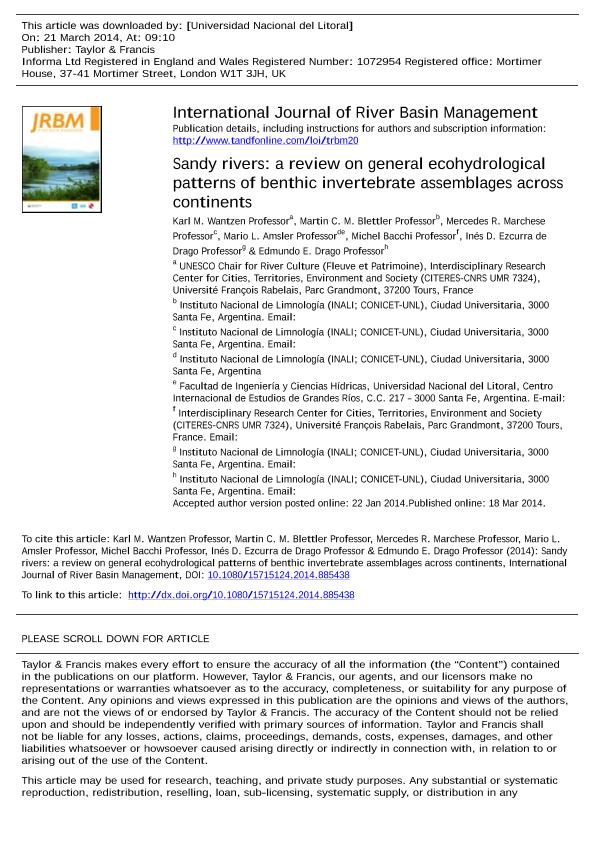Artículo
Sandy rivers: a review on general ecohydrological patterns of benthic invertebrate assemblages across continents
Wantzen, Karl Matthias; Blettler, Martin Cesar Maria ; Marchese Garello, Mercedes Rosa
; Marchese Garello, Mercedes Rosa ; Amsler, Mario Luis
; Amsler, Mario Luis ; Bacchi, Michel; Ezcurra, Ines Delia
; Bacchi, Michel; Ezcurra, Ines Delia ; Drago, Edmundo Carlos E.
; Drago, Edmundo Carlos E.
 ; Marchese Garello, Mercedes Rosa
; Marchese Garello, Mercedes Rosa ; Amsler, Mario Luis
; Amsler, Mario Luis ; Bacchi, Michel; Ezcurra, Ines Delia
; Bacchi, Michel; Ezcurra, Ines Delia ; Drago, Edmundo Carlos E.
; Drago, Edmundo Carlos E.
Fecha de publicación:
03/2014
Editorial:
Taylor & Francis
Revista:
International Journal of River Basin Management
ISSN:
1571-5124
e-ISSN:
1814-2060
Idioma:
Inglés
Tipo de recurso:
Artículo publicado
Clasificación temática:
Resumen
The middle and lower sections of most large rivers have fine-grained bed sediments, which may have a strong influence on the functional and taxonomical structure of benthic invertebrates. Based on results from several studies by the authors on the faunal assemblages and habitat structures of the Paraguay-Paraná River system (Brazil, Paraguay, Argentina), from European (Rhine, Loire) River systems, and data from the literature, this review identifies general patterns which appear to have a global character. At one hand the invertebrate assemblages largely differed between main channel and the corresponding floodplain habitats in different sections, and also the floodplain habitats along the river channel revealed great differences in their biodiversity. At the other hand there was a remarkable homogeneity among the main-channel sections within and even between river systems. We consider physical habitat features as the crucial variable responsible for these patterns. In cross sections from the main channel towards the floodplain habitats, grain size, organic matter content and oxygen supply change dramatically, and different floodplain habitats along the same river system may have different successional stages even at small geographical distances. The sandy structure of potamal habitats (including underwater dunes), however, provides a set of habitat features characterized by continuously changing sediment structures with well-defined grain sizes, low organic matter contents, and good oxygenation, which force a set of adaptations by the invertebrates that limits but stabilizes the diversity of invertebrates in these large river sections. A better understanding of the ecohydrological interactions between habitat dynamics and benthic invertebrates is needed to improve sustainable river ecosystem management. We discuss the nonrecovery of large benthic invertebrate species in the lower section of large rivers after improvement of the water quality in the context of these ecohydrological features. Conclusions are drawn for river restoration.
Archivos asociados
Licencia
Identificadores
Colecciones
Articulos(INALI)
Articulos de INST.NAC.DE LIMNOLOGIA (I)
Articulos de INST.NAC.DE LIMNOLOGIA (I)
Citación
Ezcurra, Ines Delia; Bacchi, Michel; Amsler, Mario Luis; Marchese Garello, Mercedes Rosa; Blettler, Martin Cesar Maria; Wantzen, Karl Matthias; et al.; Sandy rivers: a review on general ecohydrological patterns of benthic invertebrate assemblages across continents; Taylor & Francis; International Journal of River Basin Management; 12; 3; 3-2014; 163-174
Compartir
Altmétricas



